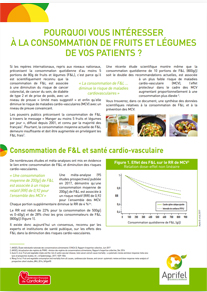Polyphenols from fruit and vegetable and their effects on the glycemic control and metabolic parameters in individuals with type 2 diabetes

Individuals with type 2 diabetes have relative insulin deficiency and peripheral insulin resistance (American Diabetes Association, 2020). Uncontrolled type 2 diabetes can lead to prolonged hyperglycemia, potentially destroying nerves and blood vessels, leading to neuropathy, nephropathy, retinopathy, and cardiovascular diseases. A healthy diet rich in fruit and vegetables is recommended for type 2 diabetes prevention and management. Indeed, the Medical Nutrition Therapy Guidelines for type 2 diabetes recommend a daily intake of at least five servings of fruit and vegetables to help people attain and maintain normal blood glucose levels (Malaysian Dietitian’s Association, 2013). Polyphenols, bioactive compounds found in fruit and vegetables, may explain their benefits for type 2 diabetes, in addition to dietary fibers. Therefore, this review aims to summarize the effects of polyphenols mainly found in the fruit and vegetables on the glycemic control and metabolic parameters, in pre- and post-intervention between polyphenol-treated and placebo groups in patients with diabetes type 2.
A wide variety of polyphenols from plants-based with antioxidant activity
Polyphenols are naturally secondary metabolites in plants such as fruit, vegetables, legumes and cereals, with over 8,000 polyphenols compounds identified. Polyphenols differ in the number and bonding structure of phenol rings (Kim, 2016). Their main function is generally to defend the plant against aggression, particularly ultraviolet radiation and pathogens. Polyphenols are divided into 2 classes: flavonoids (flavanols, flavonols, flavanones, flavones, isoflavones, anthocyanins) and non-flavonoids like phenolic acids, stilbene and lignans (Pandey, 2009 ; Kim, 2016). In addition their health benefits, the presence of polyphenolic compounds in foods can affect sensory properties such as taste, flavor, color and odor (Pandey, 2009). There is growing interest from researchers in understanding the effects of polyphenols on blood glucose levels. Furthermore, the poor absorption of dietary polyphenols resulted in a large proportion of the ingested polyphenols reaching the colon, where they can modulate the relative abundance of gut microbiota and hinder dysbiosis, an alteration in the gut microbiota, which is associated with obesity and the pathogenesis of type 2 diabetes (Wang, 2021). Polyphenols found in fruit and vegetables are essential and therefore, patients with type 2 diabetes are encouraged to consume the recommended intake of fruit and vegetables.
Polyphenols from fruit and vegetables can have a significant improvement in glycemic contro
Nine intervention studies examining the effect of various polyphenols on glycemic control and metabolic parameters have been selected (table 1).
| Sources/types of flavonoid | Dose (mg/dL) | Duration of intervention | Number of participants | Results | Studies references |
| Purified anthocyanins capsules from natural bilberry and black-currant |
320 | 12 weeks | 160 | FBG: no change HbA1c: decrease Insulin: no change TC and TG: no change HDL-C and LDL-C: decrease |
Yang, 2017 |
| Resveratrol capsules | 480 | 4 weeks | 43 | FBG: no change Insulin: decrease HOMA-IR: decrease TG: no change |
Zare Javid, 2017 |
| Resveratrol capsules | 800 | 8 weeks | 45 | FBG: decrease HbA1c: no change Insulin: decrease HOMA-IR: decrease HDL-C: decrease TC and TG: no change LDL-C: decrease |
Khodabandehloo, 2018 |
| Resveratrol capsules | 1,000 | 8 weeks | 71 | FBG: decrease HbA1c: no change Insulin: decrease HOMA-IR: decrease TC, TG, and LDL-C: no changes HDL-C: increase |
Abdollahi, 2019 |
| Bergamot polyphenolic fraction | 650 | 30 days | FBG: decrease TC, TG, and LDL-C: decrease HDL-C: increase |
Mollace, 2019 | |
| Freeze-dried blueberries | 22 (contain 262 mg anthocyanins) | 8 weeks | 60 | HbA1c and TG were significantly lower in freeze-dried blueberries than placebo groups |
Stote, 2020 |
| Purified anthocyanins capsules from natural bilberry and black-currant | 320 | 12 weeks | 138 | FBG: no change HbA1c: decrease HOMA-IR: no change TC and TG: no change HDL-C and LDL-C: decrease |
Yang, 2021 |
| Powdered anthocyanins capsules from natural bilberry and black- currant |
320 | 4 weeks | 26 | FBG: decrease LDL-C: decrease TC, TG, and HDL-C: no change |
Nikbakht, 2021 |
| Resveratrol capsules | 1,000 | 5 weeks | 28 | There were no significant differ- ences in FBG and HbA1c between resveratrol and placebo treatments |
Thazhath, 2016 |
Six out of the 9 studies selected (table 1) reported that groups supplemented with polyphenols showed significant improvements in glycemic control based on the reductions in fasting blood sugar (FBG) (Khodabandehloo, 2018 ; Abdollahi, 2019 ; Nikbakht, 2021) or glycated hemoglobin A1c (HbA1c) levels (Yang, 2017 ; Yang, 2021 ; Stote, 2020). This is in line with the findings from a systematic review conducted in 2017, wherein resveratrol supplementation in Type 2 diabetes resulted in significant and clinically important changes, particularly in the FBG and HbA1c levels (Zhu, 2017).
Regarding insulin levels, a significant decrease was observed after intervention with resveratrol (Zare Javid, 2017 ; Khodabandehloo, 2018 ; Abdollahi, 2019) whereas intervention with anthocyanin reported no changes (Yang, 2017 ; Yang, 2021).
Polyphenols compounds produce favorable lipid profile results
The beneficial effect observed pf resveratrol may be explained by its role as an activator of sirtuin 1, also known as silent information regulatory protein 1 (SIRT1). SIRT1 has numerous regulatory functions in the body: adiponectin secretion, inflammation, glucose production, oxidative stress, mitochondrial function and circadian rhythms. Resveratrol, like other activators of SIRT1, promotes glucose homeostasis and insulin sensitivity. In pancreatic ß-cells, SIRT1 has been shown to adjust insulin secretion, protect cells from oxidative stress and inflammation, and modulate insulin signaling (Ki-tada and Koya, 2013).
Few studies included in this review show that polyphenols have favorable effects on lipid profile, especially:
- a significant increase in HDL-C (Abdollahi, 2019 ; Mollace, 2019): this may be due to the role of polyphenols in regulating the expression of the main cholesterol transporters, facilitating the transport of excess cholesterol to the liver and intestine (Zhao, 2019).
- a significant reduction in LDL-C were identified after intervention with resveratrol (Khodabandehloo, 2018) and anthocyanin (Nikbakht, 2021 ; Yang, 2021). Anthocyanin inhibits adipocyte lipolysis by blocking the FoxO1-mediated transcription of adipose triglyceride lipase, the major lipase involved in TG break-down in adipocytes.
After intervention with resveratrol and anthocyanin supplementation, most studies report no significant change in triglycerides and total cholesterol. A decrease in the levels of these 2 lipids was observed in patients with type 2 diabetes after intervention with Bergamot polyphenolic fraction.
Based on : Zin CAJCM, Mohamed WMIW, Khan NAK, Ishak WRW. Effects of Fruit and Vegetable Polyphenols on the Glycemic Control and Metabolic Parameters in Type 2 Diabetes Mellitus: A Review. Prev Nutr Food Sci. 2022 Sep 30;27(3):257-264.
- Fruit and vegetables, source of nutrients and bioactive compounds like polyphenols, are an essential component of the healthy diet recommended in prevention and management for type 2 diabetes to prevent hyperglycemia and related complications.
- Significant reductions in fasting blood glucose, glycated hemoglobin, and low-density lipoprotein cholesterol levels were reported after resveratrol, anthocyanin, and naringin were administered to patients with prediabetes and diabetes.
- Many studies included in this review found that the effects of resveratrol and anthocyanin on glycemic control and lipid profile were inconsistent due to factors such as the period of intervention, the form and dose of polyphenol supplementation, and the baseline parameter values.
- The researchers of this study decided to continue their work by conducting a 12-week intervention to determine whether polyphenol from a local vegetable could help to improve the glycemic and metabolic profiles of Type 2 diabetes.
